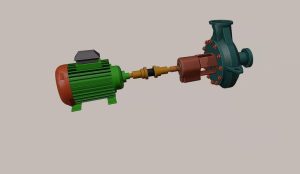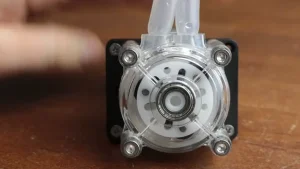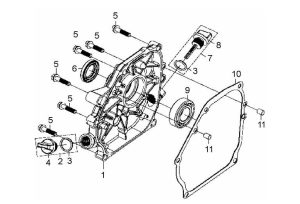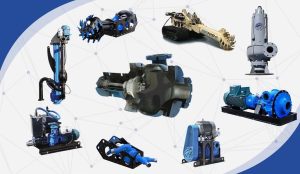Water pumps are crucial for many everyday tasks at home and in industries.
In homes, they help with activities like watering gardens, draining basements, and supplying fresh water for cooking and cleaning. In agriculture, pumps are essential for irrigation, ensuring crops receive the water they need to grow.
In industries, water pumps are used in manufacturing processes, cooling systems, and wastewater management, helping to keep operations running smoothly. They also play a vital role in firefighting systems, providing the necessary water pressure to fight fires effectively.
As water scarcity becomes a growing concern, efficient water pumps help conserve resources by delivering water where it’s needed most. Water pumps support various applications, making them indispensable for daily life and multiple sectors.
What is a Water Pump?
It’s not just a tool; it’s the heartbeat of any system that requires fluid movement. Water pumps are crucial in transporting water from one place to another, whether drawing from underground aquifers or distributing it throughout municipal systems.
How Does a Water Pump Work?
A water pump converts mechanical energy into hydraulic energy to move water from one location to another. Here’s a step-by-step explanation of how it operates:
- Power Source: The pump is powered by a motor, which can be electric, gas, or diesel. This motor provides the necessary energy for the pump’s operation.
- Suction Phase: When the pump starts, it creates a low-pressure area inside the casing. This pressure drop draws water into the pump through the suction pipe.
- Impeller Action: Inside the pump, an impeller rotates quickly. As it spins, it generates centrifugal force, pushing the water outward and increasing its speed and pressure.
- Flow Direction: The water moves through the volute or casing, which guides the flow towards the discharge pipe.
- Discharge Phase: Finally, the pressurized water exits the pump through the discharge pipe, delivering it to its intended destination, such as a garden, irrigation system, or industrial site.
This continuous cycle allows water pumps to transport water as needed efficiently.

20 Types of Water Pumps
Each type of pump is designed for specific applications, making them essential tools for effective water management across various sectors.
-
Centrifugal Pump: A Beginner’s Guide to Choosing the Best Pump
-
Submersible Pump: Why You Need a Submersible Water Pump?
-
Positive Displacement Pump: What is a Positive Displacement Pump?
-
Sump Pump: What Is A Sump Pump?
-
Well Pump: Boost Your Water Flow Today
-
Jet Pump: Explore in Details What Is A Jet Pump?
-
Diaphragm Pump: Know What is a diaphragm pump and How works?
-
Gear Pump: Know How They Work and Why You Should Choose
-
Peristaltic Pump: Read Why Choose a Peristaltic Pump?
-
Magnetic Drive Pump: Read – to Save Time and Energy
-
Self-Priming Pump: Know about Pros and Cons
-
Trash Pump: What Is a Trash Pump? – Know More
-
Solar Pump
-
Chemical Pump
-
Booster Pump
-
Piston Pump
-
Rotary Vane Pump
-
Borehole Pump
-
Fountain Pump
-
Hydraulic Pump
Centrifugal Pump
A centrifugal pump is a common type of water pump that moves water using a rotating impeller. When the pump is turned on, the motor spins the impeller, which creates a force that pushes the water outwards. This action generates pressure, allowing water to flow through the pump and into the pipes.
Centrifugal pumps are widely used in various applications, including homes, farms, and industries. They are efficient for quickly moving large volumes of water and are relatively easy to maintain. These pumps are ideal for irrigation, water supply, and drainage. Their simple design and effectiveness make centrifugal pumps popular for water management.
Submersible Pump
A submersible pump is a type of water pump designed to operate underwater. It is fully submerged in the water it pumps, making it very efficient for moving water from deep sources, such as wells or flooded areas.
When the pump is powered on, an electric motor drives an impeller, which pushes water up through a discharge pipe. Submersible pumps are used for residential water supply, irrigation, and drainage. They are known for their ability to lift water from great depths and for being quieter than other pumps.
Because they are enclosed and protected, submersible pumps are less prone to damage from the elements, making them ideal for outdoor use. Their effectiveness and reliability make them popular for various water management tasks.
Positive Displacement Pump
A positive displacement pump is a type of pump that moves water by trapping a fixed amount of liquid and forcing it through the discharge pipe. Unlike other pumps that rely on speed, positive displacement pumps create a vacuum that pulls in water and physically pushes it out.
These pumps are particularly effective for moving thick liquids or fluids with varying viscosities, making them ideal for applications in industries like oil and gas, food processing, and chemical manufacturing. They can handle high pressures and provide a consistent flow rate, regardless of the system’s pressure conditions.
Positive displacement pumps come in various designs, including gear, diaphragm, and piston types. Their reliability and efficiency make them popular for demanding applications where precise flow control is essential.
Sump Pump
A sump pump is a device used to remove excess water from basements or crawl spaces, preventing flooding and water damage. It is typically installed in a pit or sump basin where water naturally collects.
When water levels rise, the sump pump automatically activates, pumping the water out of the pit and away from the building. This helps keep the area dry and protects your home from mold and structural issues.
Sump pumps are handy in areas with heavy rainfall or high groundwater levels. They come in two main types: submersible pumps, placed underwater, and pedestal pumps, which sit above the water level. Both types effectively manage water and ensure a safe, dry environment. Their reliable operation makes sump pumps an essential part of home maintenance for many homeowners.
Well Pump
A well pump is a device used to draw water from underground wells. It’s essential for homes and farms that rely on healthy water for drinking, irrigation, and other uses.
Two main types of well pumps are submersible and jet pumps. Submersible pumps are placed deep inside the well and push water to the surface, while jet pumps are located above ground and use suction to pull water up.
Well pumps work by activating when you turn on the water supply in your home, drawing water from the well and delivering it through pipes. They are designed to be durable and efficient, ensuring a consistent water supply. Regular maintenance is essential to keep them running smoothly. Overall, well pumps provide reliable access to fresh water from deep underground sources.
Jet Pump
A jet pump is a well pump used to draw water from underground sources, particularly in shallow wells. It uses a combination of suction and pressure to lift water to the surface.
Jet pumps are usually installed above ground and have a motor that powers a jet assembly. When the pump is turned on, it creates a vacuum that pulls water through a pipe from the well and into the pump. The water is then pressurized and sent to your home or irrigation system.
These pumps are popular for residential use because they are effective for 25 feet deep or less wells. Jet pumps are also relatively easy to install and maintain. They provide a reliable water source, making them a common choice for households dependent on healthy water.
Diaphragm Pump
A diaphragm pump is a positive displacement pump that moves fluids using a flexible diaphragm. When the diaphragm moves up and down, it creates a vacuum that draws liquid into the pump and then pushes it out through a discharge valve. This action allows the pump to handle a variety of fluids, including thick liquids and slurries.
Diaphragm pumps are known for maintaining a steady flow and operating quietly. They are often used in chemical processing, water treatment, and food production because they can handle corrosive substances and maintain cleanliness.
These pumps come in different designs, such as air-operated and electrically driven, making them versatile for many uses. Diaphragm pumps are reliable and efficient, making them popular for moving liquids in various industries.
Gear Pump
A gear pump is a positive displacement pump that moves fluids using rotating gears. It consists of two or more gears that mesh together, creating spaces that trap and transfer liquid as they turn. When the gears rotate, they draw fluid into the pump and push it through the discharge port.
Gear pumps are known for handling thick liquids and maintaining a steady flow, making them ideal for applications in oil and gas, chemical processing, and food production. They are also relatively simple in design, which makes them easy to maintain.
These pumps can be either internal, where the gears are enclosed within the pump casing, or external, where the gears are outside. Overall, gear pumps are reliable and efficient, making them popular for moving fluids in many settings.

Peristaltic Pump
A peristaltic pump is a unique pump that moves liquids by squeezing a flexible tube. As rollers press down on the tube, they create a wave-like motion that pushes the liquid through. This design allows the pump to handle various fluids, including corrosive and sensitive materials, without contamination.
Peristaltic pumps are easy to clean and maintain, making them ideal for industries like food processing and pharmaceuticals. Their gentle action ensures that the liquids are transferred without damage, making them a reliable choice for precise fluid handling.
Magnetic Drive Pump
A magnetic drive pump is a type of pump that uses magnets to transfer power from the motor to the impeller without direct contact. This design eliminates the need for seals, reducing the risk of leaks.
As the motor turns, magnets drive a set of magnets on the impeller, causing it to spin and move the liquid. Magnetic drive pumps are handy for handling corrosive or hazardous fluids, providing a safe and leak-free operation. They are commonly used in chemical processing, water treatment, and other applications where reliability is essential.
Self-Priming Pump
A self-priming pump is designed to lift water from a lower level without manual priming. It has a unique feature that allows it to create a vacuum, drawing water into the pump automatically.
Once the pump starts, it can quickly expel air and move water efficiently. Self-priming pumps are ideal for draining flooded areas, irrigation, and water supply. Their ease of use and ability to handle air in the system makes them a popular choice for residential and industrial purposes.
Trash Pump
A heavy-duty trash pump handles dirty water mixed with debris, such as mud, leaves, and small rocks. It features a larger inlet to prevent clogging, making it ideal for tough jobs like draining flooded areas, construction sites, or agricultural fields.
Trash pumps are powerful and efficient, capable of quickly moving large volumes of wastewater. They are commonly used in construction, emergency flood relief, and other applications where clean water cannot be guaranteed. Their robust design ensures reliable performance in challenging conditions.
Solar Pump
A heavy-duty trash pump handles dirty or debris-filled water, such as wastewater, from construction sites or flooded areas. It can quickly move water mixed with solids like mud, leaves, and small rocks.
Trash pumps have larger inlet openings and powerful engines to prevent clogging, making them ideal for tough jobs. They are commonly used in construction, agriculture, and emergency flood relief. Their ability to efficiently handle challenging conditions makes them a reliable choice for moving wastewater quickly.
Chemical Pump
A chemical pump is designed to handle and transfer corrosive or hazardous liquids safely. These pumps use materials that resist chemical reactions, ensuring long-lasting performance.
Commonly found in industries like chemical manufacturing, pharmaceuticals, and water treatment, chemical pumps can move various substances, including acids, bases, and solvents. They come in different types, such as diaphragm and magnetic drive pumps, to suit specific needs. Their durability and reliability make them essential for safely managing chemicals in various applications.
Booster Pump
A booster pump is a device that increases water pressure in a system. It is commonly used in homes, irrigation systems, and commercial buildings to ensure water flows efficiently, especially in weak water supply.
When installed, the booster pump takes in water and uses a motor to increase pressure before delivering it through pipes. This helps improve water flow for showering, watering gardens, or supplying appliances. Booster pumps maintain consistent water pressure and ensure reliable application performance.
Piston Pump
A piston pump is a positive displacement pump that moves fluids using a piston inside a cylinder. When the piston moves back and forth, it creates a vacuum that draws fluid in and pushes it out through a discharge valve.
Piston pumps are known for handling high pressures and providing precise flow control, making them ideal for applications like hydraulic systems, water treatment, and oil extraction. Their durability and efficiency make them a popular choice for moving various liquids in many industries.
Rotary Vane Pump
A rotary vane pump is a positive displacement pump that uses rotating vanes to move fluids. As the rotor spins, the vanes slide in and out, creating chambers that trap and transfer liquid.
These pumps are known for their ability to handle a variety of fluids, including oils and chemicals, with a consistent flow rate. Rotary vane pumps are efficient and relatively quiet, making them suitable for automotive, industrial, and HVAC applications. Their simple design and reliable performance make them a popular choice for moving liquids smoothly.
Borehole Pump
A borehole pump is a submersible pump that draws water from deep underground wells or boreholes. It is installed below the water level and uses a motor to push water up through a pipe to the surface.
Borehole pumps are used for agricultural irrigation, drinking water supply, and industrial applications. They are efficient and can handle varying water levels, making them ideal for areas with deep water sources. Their durable design ensures reliable performance in challenging environments, providing a consistent water supply whenever needed.
Fountain Pump
A fountain pump is a small pump designed to create and maintain water features in gardens, ponds, or decorative fountains. It circulates water to produce flowing or spraying effects, enhancing the visual appeal of outdoor spaces.
Fountain pumps are easy to install and come in various sizes to suit different features. They are typically energy-efficient and can be powered by electricity or solar energy. These pumps add beauty to landscapes and help oxygenate the water, promoting a healthy environment for fish and plants.
Hydraulic Pump
A hydraulic pump is a device that converts mechanical energy into hydraulic energy to move fluids in hydraulic systems. It generates pressure by forcing hydraulic fluid through pipes to power machinery, such as construction equipment, lifts, and industrial machines.
These pumps come in various types, including gear, piston, and vane pumps, each designed for specific applications. Hydraulic pumps provide the force needed to operate heavy machinery, making them essential in construction, manufacturing, and automotive industries. Their efficiency and reliability enable smooth operation in many mechanical systems.

The water pump parts detail:
- Motor: The power source that drives the pump, usually electric or gas-powered.
- Impeller: A rotating component that creates flow by pushing water through the pump.
- Volute: A spiral-shaped casing that directs water flow from the impeller to the discharge pipe.
- Suction Pipe: The pipe through which water enters the pump.
- Discharge Pipe: The pipe that carries water out of the pump.
- Seal: Prevents leaks between the pump components, protecting the motor and other parts.
- Bearing: Supports the rotating shaft and reduces friction, allowing smooth operation.
- Strainer: Filters debris and particles from the water before entering the pump.
- Casing: The outer shell that houses the internal components and protects them.
- Base or Frame: Provides stability and support for the entire pump assembly.
These parts work together to ensure the efficient operation of the water pump.
Applications of Water Pumps
Water pumps are used in many different ways, making them essential in our daily lives. Here are some key applications:
- Homes: Water pumps help water gardens, drain basements, and provide clean water for drinking and cooking.
- Farming: They are crucial for irrigating crops, ensuring plants get enough water, and supplying water for livestock.
- Industry: In factories, pumps move water for cooling machines and help manage wastewater, keeping operations running smoothly.
- Commercial Buildings: Pumps are used in heating and cooling systems and provide water pressure for fire safety systems.
- Construction Sites: They remove excess water to keep construction areas dry and safe.
- Aquaculture: In fish farming, pumps circulate water in tanks and ponds to keep fish healthy.
- Fountains and Pools: Water pumps create beautiful water displays in parks and keep swimming pools clean.

Key Considerations When Choosing a Water Pump
Here’s a simple guide:
- Purpose: Determine what you need the pump for. Is it for watering a garden, draining water, or supplying water for a home? Different pumps are designed for other tasks.
- Flow Rate: This measures how much water the pump can move in a specific time (usually gallons per minute). Make sure the pump can handle the amount of water you need.
- Head Pressure: This is the pump’s height to lift the water. If you’re moving water uphill, you’ll need a pump with enough power to handle that distance.
- Power Source: Consider how the pump will be powered. It can be electric, gas, or even solar. Choose one that fits your situation.
- Size and Portability: Think about where you’ll use the pump. If you need to move it around, a lighter and smaller pump may be better.
- Durability: Look for pumps made from solid materials, mainly if used outdoors or in harsh conditions.
- Maintenance: Some pumps require more upkeep than others. Check how easy it is to maintain the pump you’re considering.
You can choose the right water pump for your needs.
Environmental Impact and Sustainability of Water Pump
Water pumps can impact the environment, but there are ways to use them sustainably. Some key points for you.
- Energy Use: Many water pumps require electricity or fuel to operate. Using energy-efficient pumps can reduce energy consumption and lower greenhouse gas emissions. Choosing solar-powered pumps is an even greener option.
- Water Conservation: Efficient pumps help deliver water where it’s needed without wasting it. This is important in areas facing water shortages. Using pumps wisely can help conserve this precious resource.
- Pollution Control: Some pumps are used in wastewater management to treat and transport sewage. Properly maintained pumps can prevent leaks and pollution, protecting local water sources.
- Ecosystem Impact: When extracting water from rivers or lakes, ensuring the ecosystem is not harmed is essential. Sustainable practices include monitoring water levels to avoid over-extraction.
- Materials: Choosing pumps made from durable, recyclable materials can reduce waste. This not only helps the environment but can also lower long-term costs.
If you’re considering these factors, you can use water pumps in ways that support sustainability and protect the environment.
Future Trends in Water Pump Technology
Here are some future trends in water pump technology:
- Smart Pumps: Integration of IoT (Internet of Things) technology allows pumps to be monitored and controlled remotely. This enables real-time data collection for efficiency and maintenance alerts.
- Energy Efficiency: Future pumps will focus on reducing energy consumption through advanced designs and materials, leading to lower operational costs and reduced environmental impact.
- Solar-Powered Pumps: Increasing the use of solar energy will drive the development of pumps powered by solar panels, making them more sustainable and reducing reliance on traditional power sources.
- Variable Speed Drives: These systems allow pumps to adjust their speed based on demand, optimizing performance and energy use and preventing wear and tear.
- Advanced Materials: Innovations in materials, such as corrosion-resistant and lightweight composites, will improve durability and efficiency, extending the lifespan of pumps.
- Predictive Maintenance: Using AI and machine learning, future pumps will be equipped to predict failures before they occur, reducing downtime and maintenance costs.
- Environmental Monitoring: Pumps will increasingly be designed to monitor water quality and environmental conditions, allowing for better management of water resources.
- Modular Designs: Future pumps may have modular components, making them easier to repair and upgrade, enhancing flexibility in various applications.
These trends indicate a shift towards more efficient, sustainable, and intelligent water pump systems, addressing modern challenges in water management.
In Verdict
understanding water pump functionality and benefits is crucial for residential and commercial applications. These devices ensure efficient water delivery for irrigation, plumbing, and various industrial processes.
When selecting the correct type of pump based on your specific needs—submersible, centrifugal, or diaphragm—you can significantly enhance water management and reduce energy costs. Regular maintenance is also essential to prolong the lifespan of your pump and ensure optimal performance.
Take the time to assess your requirements today and choose a water pump that will meet your demands effectively!

